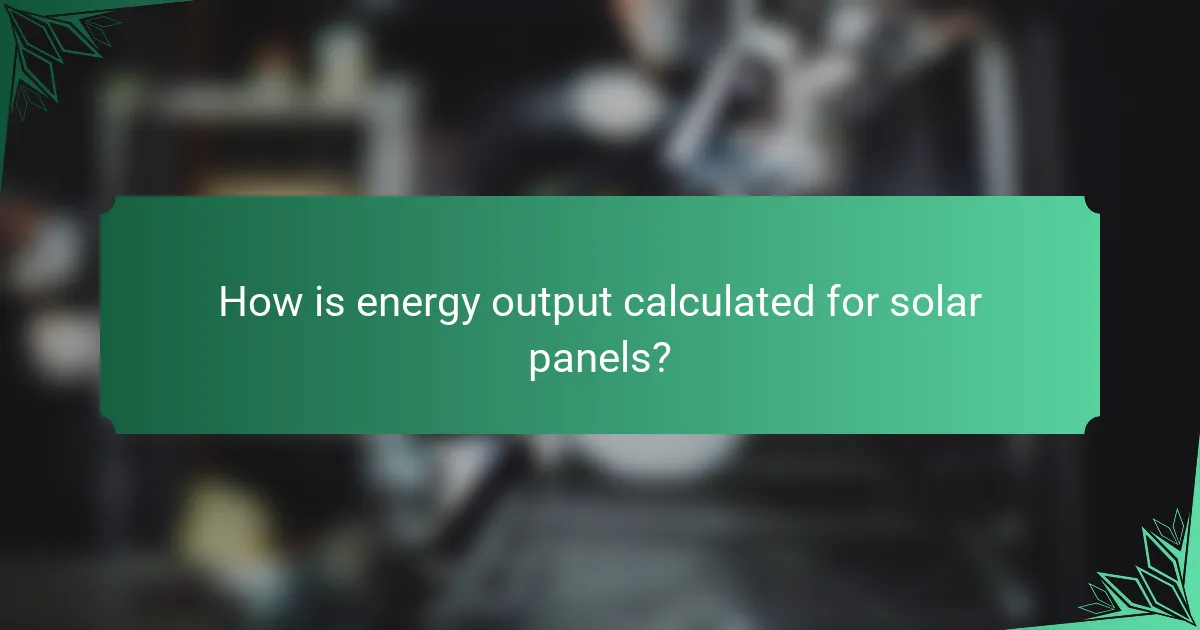
What are the key metrics of solar panel efficiency ratings?
The key metrics of solar panel efficiency ratings include conversion efficiency, temperature coefficient, and power output. Conversion efficiency measures the percentage of sunlight converted into usable electricity. High-efficiency panels typically have ratings between 15% and 22%. The temperature coefficient indicates how much efficiency decreases as temperatures rise. A lower temperature coefficient means better performance in heat. Power output, measured in watts, reflects the energy produced under standard test conditions. This metric varies based on panel size and efficiency. Collectively, these metrics help assess a solar panel’s performance and suitability for specific applications.
How is solar panel efficiency measured?
Solar panel efficiency is measured by calculating the ratio of electrical output to the sunlight input. This is expressed as a percentage. The standard test conditions for measurement include a solar irradiance of 1000 watts per square meter and a cell temperature of 25 degrees Celsius. Efficiency is determined by dividing the power output (in watts) by the incident solar energy (in watts per square meter) and multiplying by 100. For example, a solar panel producing 300 watts under these conditions would have an efficiency of 18% if its area is 1.67 square meters. Measurements are typically conducted using specialized equipment in controlled environments to ensure accuracy.
What are the standard efficiency rating percentages?
Standard efficiency rating percentages for solar panels typically range from 15% to 22%. Most conventional solar panels have efficiencies around 15% to 18%. Higher-end models can achieve efficiencies above 20%. The highest recorded efficiency for commercial solar panels is approximately 23%. These percentages reflect the portion of sunlight converted into usable electricity. Efficiency ratings are crucial for comparing solar panel performance. Higher efficiency means more power generation from the same area. This is essential for maximizing energy output in limited spaces.
How do different types of solar panels compare in efficiency?
Monocrystalline solar panels generally have the highest efficiency rates among various types. Their efficiency can reach up to 22% or more. This is due to their high purity silicon and advanced manufacturing processes.
Polycrystalline panels typically offer lower efficiency, ranging from 15% to 20%. They are made from multiple silicon crystals, which reduces their efficiency compared to monocrystalline panels.
Thin-film solar panels have the lowest efficiency, usually between 10% to 12%. They are made from a variety of materials and are less efficient due to their lower energy conversion capabilities.
In summary, monocrystalline panels lead in efficiency, followed by polycrystalline, and then thin-film panels. This hierarchy is supported by their respective manufacturing processes and material compositions.
Why are efficiency ratings important for consumers?
Efficiency ratings are important for consumers because they indicate how effectively a solar panel converts sunlight into electricity. Higher efficiency ratings mean more energy production from the same amount of sunlight. This translates to greater savings on energy bills and a faster return on investment. For instance, panels with an efficiency rating of 20% produce more energy than those rated at 15%. Consumers can compare different solar panel options and make informed decisions based on these ratings. Additionally, efficiency ratings can influence the overall system size required for a home, impacting installation costs and space requirements. Thus, understanding efficiency ratings helps consumers maximize their energy output and investment in solar technology.
How do efficiency ratings impact long-term energy savings?
Efficiency ratings directly influence long-term energy savings by indicating how effectively a solar panel converts sunlight into usable electricity. Higher efficiency ratings mean that more energy is produced from the same amount of sunlight. For example, a solar panel with a 20% efficiency rating generates more power than one with a 15% rating under identical conditions. This increased energy output leads to reduced reliance on grid electricity, resulting in lower utility bills over time. Studies show that investing in higher efficiency panels can yield significant savings, often recouping the initial cost within a few years. As a result, efficiency ratings serve as a critical metric for evaluating the long-term financial benefits of solar energy systems.
What role do efficiency ratings play in choosing solar panels?
Efficiency ratings are crucial in selecting solar panels. They indicate how effectively a solar panel converts sunlight into electricity. Higher efficiency ratings mean more energy output from the same amount of sunlight. This leads to better performance in limited space. For instance, a panel with a 20% efficiency rating generates more power than one with 15%. Efficiency ratings also influence overall system costs. More efficient panels may require fewer units to achieve desired energy production. This can lower installation and maintenance costs. Therefore, efficiency ratings are a key factor in optimizing solar energy systems.

What factors influence solar panel conversion rates?
Solar panel conversion rates are influenced by several key factors. The efficiency of the solar cells is a primary factor. Higher efficiency cells convert more sunlight into electricity. The angle and orientation of the panels also impact conversion rates. Panels should be positioned to maximize sunlight exposure throughout the day. Temperature affects performance as well. Higher temperatures can reduce the efficiency of solar panels. Additionally, shading from trees or buildings can significantly decrease energy output. The quality of materials used in panel construction plays a role too. Higher quality materials typically yield better performance and longevity. Finally, the installation process can affect overall efficiency. Proper installation ensures optimal performance and minimizes energy loss.
How do environmental conditions affect conversion rates?
Environmental conditions significantly impact conversion rates in solar panel efficiency. Factors such as temperature, sunlight intensity, and humidity directly influence how effectively solar panels convert sunlight into electricity. For instance, higher temperatures can reduce the efficiency of solar cells, leading to lower conversion rates. Conversely, optimal sunlight intensity enhances energy production. Research indicates that solar panels perform best at cooler temperatures, with efficiency dropping by about 0.5% for every degree Celsius increase above 25°C. Additionally, high humidity can lead to increased shading and reduced sunlight exposure, further affecting conversion rates. Therefore, understanding these environmental variables is crucial for optimizing solar panel performance.
What is the impact of temperature on solar panel performance?
Temperature negatively impacts solar panel performance. As temperature increases, the efficiency of solar panels generally decreases. For every degree Celsius rise in temperature, solar panel efficiency can drop by approximately 0.5% to 0.8%. This is due to increased resistance in the solar cells. High temperatures can lead to lower voltage output. Consequently, the overall energy output is reduced. Studies have demonstrated that solar panels operate best at cooler temperatures. For instance, the optimal temperature range for maximum efficiency is typically between 15°C to 25°C. Beyond this range, performance declines significantly.
How does shading affect solar panel conversion rates?
Shading significantly reduces solar panel conversion rates. When solar panels are shaded, the amount of sunlight they receive decreases. This loss of sunlight directly impacts their ability to convert solar energy into electricity. Studies show that even partial shading can lead to a drop in output by 20% to 50%. In some cases, shading can cause a complete halt in energy production. This is due to the way solar cells are connected in series. If one cell is shaded, it can affect the entire string of cells. Additionally, shading can lead to hot spots, damaging the solar panel over time. Therefore, optimal placement and maintenance are crucial for maximizing solar panel efficiency.
What technological advancements improve conversion rates?
Technological advancements that improve conversion rates include artificial intelligence, machine learning, and advanced analytics. Artificial intelligence enhances personalization by analyzing user behavior. This leads to tailored recommendations that increase engagement. Machine learning algorithms optimize marketing strategies through data-driven insights. Advanced analytics provide real-time performance tracking. This allows for quick adjustments to campaigns. According to a study by McKinsey, companies using AI for marketing saw a 30% improvement in conversion rates. These technologies collectively create a more efficient sales funnel.
How do bifacial panels enhance energy conversion?
Bifacial panels enhance energy conversion by utilizing both sides of the panel to capture sunlight. This design allows them to absorb direct sunlight from the front and reflected sunlight from the ground or surrounding surfaces. Studies show that bifacial panels can increase energy output by 10% to 30% compared to traditional monofacial panels. The effectiveness of bifacial panels depends on the albedo of the surface beneath them. High-albedo surfaces, like white concrete or snow, reflect more light, thereby boosting overall energy conversion. Additionally, bifacial panels can generate electricity even in low-light conditions, improving performance during cloudy days. This dual-sided functionality maximizes the use of available sunlight, leading to higher overall efficiency.
What role does inverter technology play in conversion rates?
Inverter technology plays a crucial role in solar energy conversion rates. It converts the direct current (DC) generated by solar panels into alternating current (AC) for home use. The efficiency of this conversion directly impacts the overall energy output. High-quality inverters can achieve conversion efficiencies of 95% or more. This means that less energy is lost during the conversion process. Inverter technology also optimizes energy harvest through maximum power point tracking (MPPT). MPPT adjusts the operating point of the solar panels to maximize output under varying conditions. Therefore, advanced inverter technology enhances the overall performance and efficiency of solar energy systems.

How is energy output calculated for solar panels?
Energy output for solar panels is calculated using the formula: Energy (kWh) = Power (kW) × Time (h). The power rating of a solar panel is determined under standard test conditions, typically around 1000 W/m² solar irradiance. This rating indicates the maximum output of the panel under ideal conditions.
To estimate actual energy output, factors such as location, weather, and panel orientation are considered. For example, a panel rated at 300 W operating for 5 hours of peak sunlight would generate 1.5 kWh.
Additionally, performance ratios account for inefficiencies, such as shading and temperature effects. A performance ratio of 0.75 means that only 75% of the potential energy output is realized.
In practice, real-world energy output can vary significantly from theoretical calculations due to these factors. This approach ensures a comprehensive understanding of solar panel energy output.
What formulas are used to determine energy output?
Energy output from solar panels is determined using several key formulas. The most common formula is: Energy Output (kWh) = Peak Sun Hours (h) × System Size (kW) × Performance Ratio. This formula calculates the total energy produced over a given period. Peak Sun Hours represent the average number of hours per day that solar irradiance is at its maximum. System Size refers to the total capacity of the solar panel system in kilowatts. The Performance Ratio accounts for inefficiencies in the system, typically ranging from 0.75 to 0.85.
Another relevant formula is: Energy Output (Wh) = Solar Irradiance (W/m²) × Area of Solar Panels (m²) × Efficiency × Time (h). This formula factors in solar irradiance, the surface area of the panels, and their efficiency in converting sunlight to electricity. These formulas are widely used in solar energy assessments and help in estimating the energy that solar installations can produce under various conditions.
How does peak sun hours affect energy output calculations?
Peak sun hours directly influence energy output calculations for solar panels. Peak sun hours refer to the maximum amount of solar energy received in a specific location during a day. This metric helps determine the potential energy production of solar panels.
For instance, a location with five peak sun hours can produce more energy than one with three peak sun hours. Solar panels convert sunlight into electricity based on the intensity and duration of sunlight.
The formula for energy output is: Energy (kWh) = Solar Panel Rating (kW) x Peak Sun Hours. Thus, more peak sun hours result in higher energy output. Research indicates that locations with higher peak sun hours can increase energy production by 20-30% compared to areas with fewer hours.
What are the differences in output between residential and commercial panels?
Residential solar panels typically have lower output compared to commercial panels. Residential panels generally produce between 250 to 400 watts per panel. In contrast, commercial panels can output between 400 to 600 watts per panel. The difference in output is primarily due to size and efficiency. Commercial panels are often larger and designed for higher energy demands. Additionally, commercial installations benefit from advanced technology and optimization, which enhances energy production. This results in commercial systems generating significantly more energy overall. For instance, a typical commercial solar array can produce 100 kW or more, while residential systems usually range from 5 kW to 10 kW.
What factors can lead to discrepancies in expected energy output?
Discrepancies in expected energy output from solar panels can arise from several factors. Variability in sunlight exposure significantly influences energy generation. Weather conditions, such as cloud cover and precipitation, can reduce sunlight intensity. The angle and orientation of solar panels affect their efficiency in capturing sunlight. Dust and debris accumulation on panel surfaces can obstruct light absorption. Temperature variations impact solar panel performance; higher temperatures can decrease efficiency. Additionally, inverter efficiency plays a role in converting DC to AC power. Lastly, shading from nearby objects can significantly reduce energy output. Each of these factors can lead to a measurable difference between expected and actual energy production.
How do installation angles influence energy output?
Installation angles significantly influence energy output from solar panels. The angle affects the amount of sunlight that panels receive throughout the day. Optimal angles maximize direct sunlight exposure, enhancing energy production. Studies show that solar panels installed at a 30 to 45-degree angle yield the highest efficiency in many regions. This is due to reduced shading and increased sunlight capture during peak hours. Additionally, seasonal adjustments to angles can further improve energy output. For example, tilting panels toward the sun’s path increases energy absorption in winter months. This demonstrates the critical role of installation angles in optimizing solar energy efficiency.
What maintenance practices can optimize energy output?
Regular cleaning of solar panels optimizes energy output. Dust, dirt, and debris can accumulate on the surface. This buildup reduces sunlight absorption and decreases efficiency. Studies show that clean panels can produce up to 20% more energy. Routine inspections for damage are also crucial. Identifying and fixing issues like cracks or faulty wiring ensures optimal performance. Additionally, monitoring system performance helps detect declines in output. This proactive approach enables timely maintenance actions. Keeping vegetation trimmed around panels prevents shading, which can hinder energy production.
What are the best practices for maximizing solar panel efficiency and output?
To maximize solar panel efficiency and output, regular maintenance is essential. This includes cleaning panels to remove dust and debris. Dust can reduce efficiency by up to 25%. Proper installation angle is also critical. Panels should be positioned at an angle that maximizes sunlight exposure, typically between 30 to 45 degrees, depending on geographic location.
Using high-efficiency solar panels can significantly enhance output. Modern panels can achieve efficiencies exceeding 22%. Monitoring system performance helps identify issues early. Real-time data allows for prompt maintenance and adjustments.
Additionally, shading must be minimized. Even partial shading can drastically reduce energy production. Investing in solar optimizers or microinverters can help manage shading effects.
Lastly, ensuring the inverter is of high quality is vital. Inverters convert DC to AC power and can affect overall system efficiency. Regularly checking inverter performance ensures optimal energy conversion.
The primary entity of this article is solar panel efficiency ratings, which are critical for assessing the performance and suitability of solar panels. The article provides a detailed examination of key metrics, including conversion efficiency, temperature coefficient, and power output, explaining how these factors influence energy production. It also covers the methods of measuring efficiency, the impact of various types of solar panels, and the significance of efficiency ratings for consumers in terms of energy savings and investment. Additionally, the article addresses environmental factors affecting conversion rates, technological advancements enhancing performance, and best practices for maximizing solar panel output.